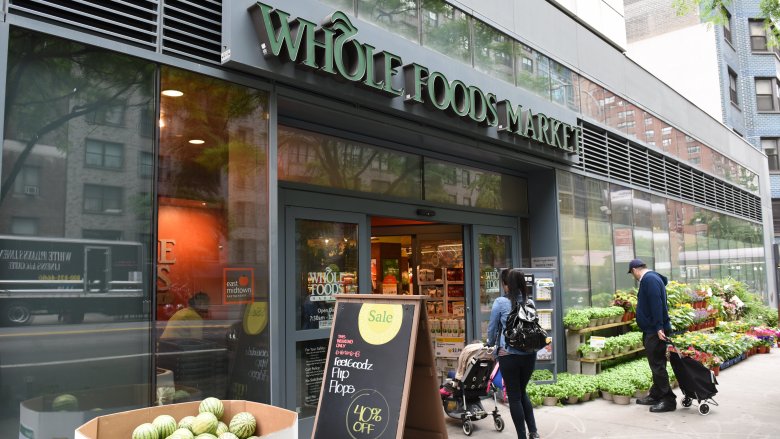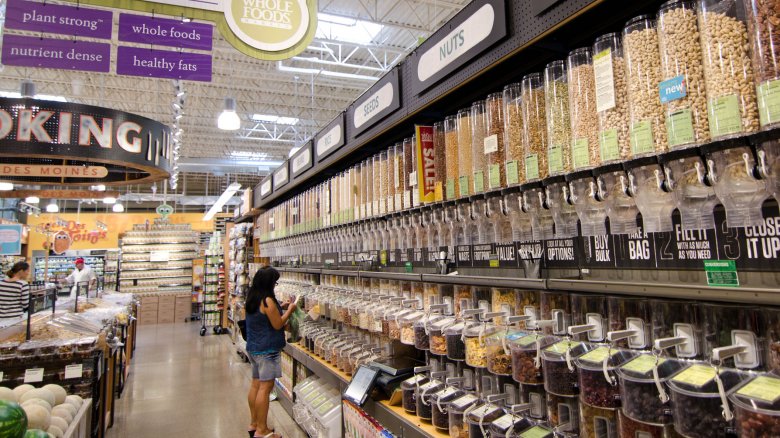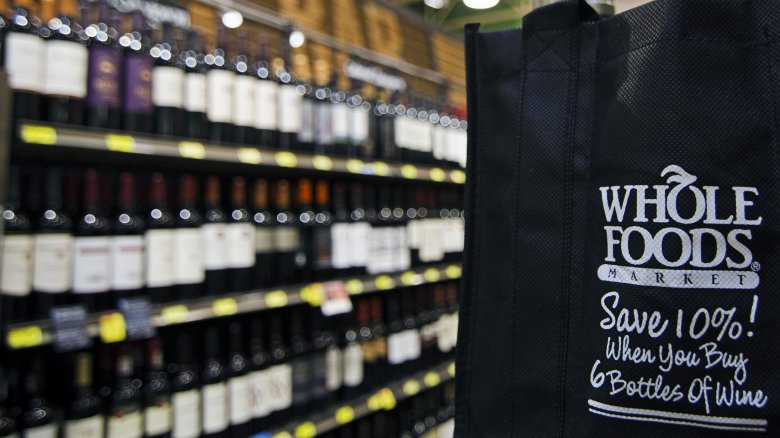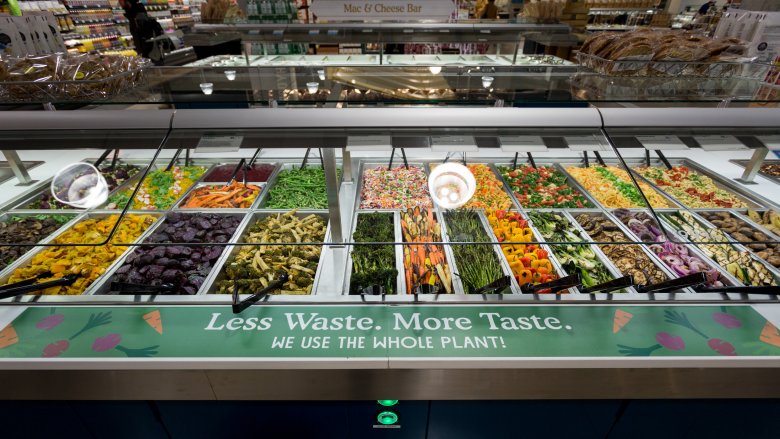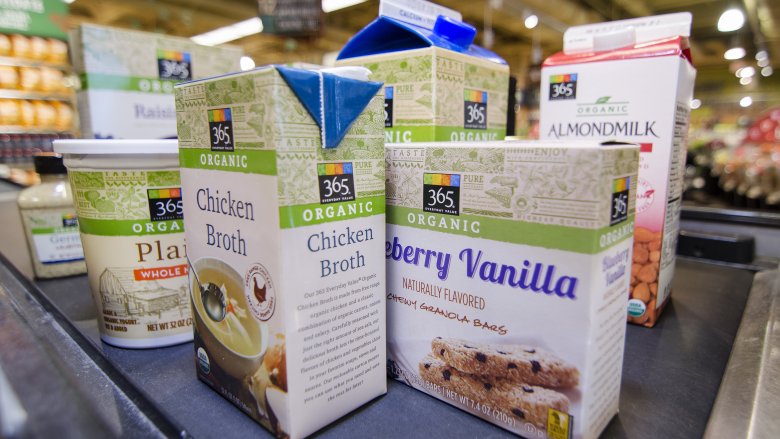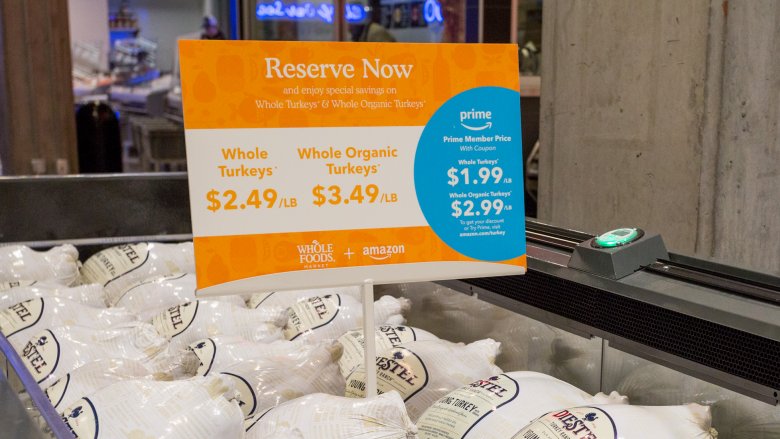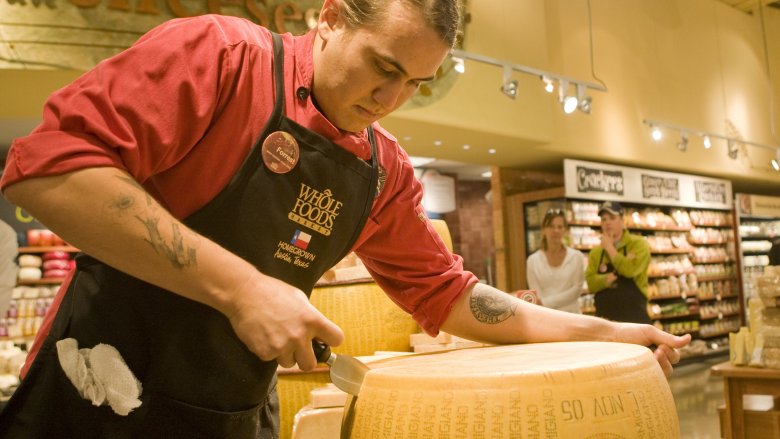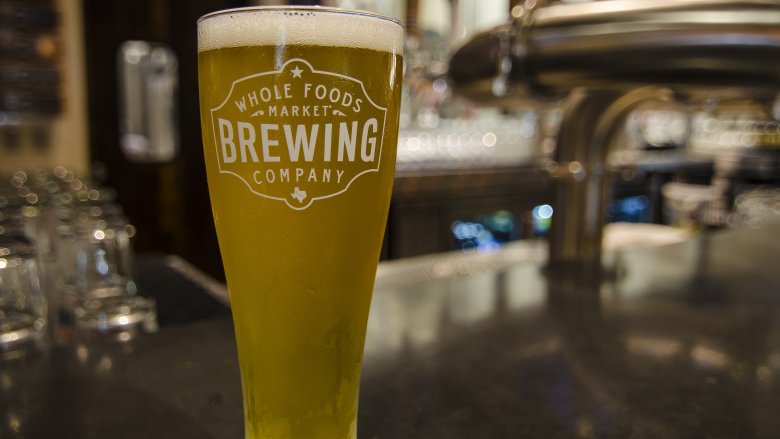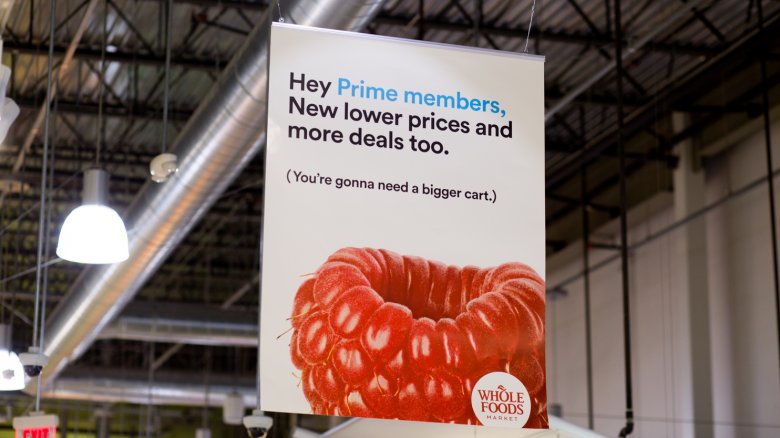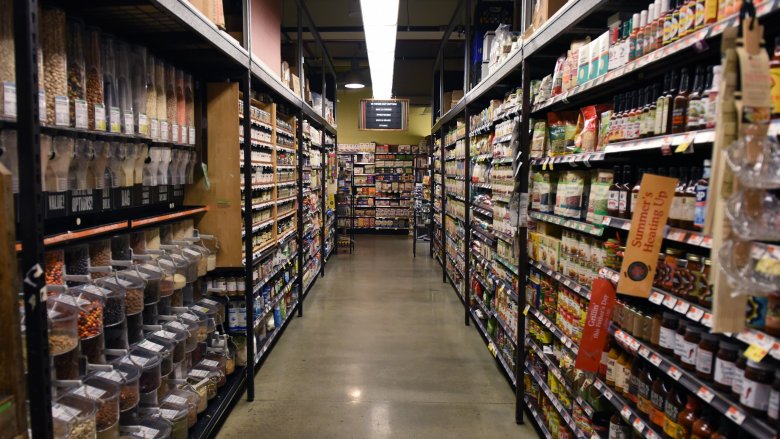Don't Go Shopping At Whole Foods Until You Read This
Whole Foods first opened (under the name SaferWay) in 1978, originally just a small natural foods store. Only two years and one partnership later, SaferWay was expanded to what was, at the time, a massive natural foods store in Austin, Texas. With 19 employees and more than 10,500 square feet to work with, the first Whole Foods was one of only a handful of natural grocery stores in the country, and certainly one of the biggest. The original store went on to birth a behemoth.
These days, there are more than 500 locations in North America and the United Kingdom, and Whole Foods has won a reputation as one of the best grocery store chains in the U.S.
The chain became even more ubiquitous when it was purchased by online retailer Amazon in 2017 for a whopping $13.7 billion. Now, shoppers can find a whole host of integrations between Whole Foods and Amazon Prime, from online shopping with Prime Now service to getting special in-store discounts.
While most of us have probably heard of Whole Foods, maybe you haven't experienced it yourself. And whether you're a frequent shopper or a first-timer, there are likely some tips and tricks you could use to make your shopping experience better. Here are some of the things you'll need to know before you step food into Whole Foods.
You can save money at the bulk bins, but there's one item to skip
If you're looking for both unique dry goods and pantry staples at a bargain price, the bulk bin aisle should be your first stop at Whole Foods, especially when trying out a new recipe or a new ingredient. That way you can buy exactly the amount you need, and if it turns out you actually hate eating steel cut oats for breakfast, you won't be left with a nearly full container to throw away or let otherwise go to waste.
On the other end of the spectrum, it's a good way to stock up on pantry items you know you'll use. Ingredients as diverse as pink Himalayan salt, nutritional yeast, black lentils, and dried mulberry can all be found in the Whole Foods bulk bins (depending on location), and they're usually much less expensive compared to the items sold on the shelf.
Another advantage of buying bulk is doing away with all the extra packaging that pre-packaged goods come in. Not only does it save you money on the product itself, but it's also better for the environment. You can even bring reusable containers in from home — just have the cashier zero out the weight before you fill your containers up.
The one ingredient you might want to skip getting from the Whole Foods bulk bins? Nuts, which you can find for almost 50% less elsewhere.
Purchase by the case for more discounts
If there's a product you already know you love, and that you use often, consider buying it by the case. Whole Foods offers case discounts of 10 percent on most items, and you can handily see how many units are included in a case on the shelf tag for most products.
This is a great way to save on things like pet food, canned goods, and paper products that you know you'll end up using and which won't go bad if they linger for awhile in the pantry.
You can get the 10 percent discount for buying large quantities of other items, too. From Thursday-Tuesday, you get 10 percent off any six bottles of wine, and on "Wine Down Wednesdays," you can get 10 percent off your first 1-5 bottles, and another 10 percent off when you buy six or more.
There's a 10 percent discount to be had at the bulk bins too, for shoppers who load up on 25 pounds or more.
You might want to bring a straw
Unlike some smaller specialty organic and health food stores, Whole Foods is like a typical grocery store in a lot of ways, including that inside many of the chain's stores you can find a coffee shop, a juice bar, and even a wine and beer bar (depending on your location).
In the past, when you ordered an iced beverage at the coffee bar or a cold juice or smoothie at the juice bar, you would also receive a plastic straw. That will no longer be the case as of July 2019, as Whole Foods recently became the first major grocery store in the U.S. to ban plastic straws.
Whole Foods estimates that banning the straws (along with some other plastic packaging changes) will result in eliminating more than 800,000 pounds of plastic waste each year. In lieu of plastic straws, the company says it will offer Forest Stewardship Council-certified, recyclable, and compostable paper straws, but they will have plastic straws available on request for customers with disabilities.
Even better? If you're able-bodied, bring your own reusable straw with you if you're going to grab a cold drink while you shop, and help reduce waste even more (and as an added bonus, you'll avoid that soggy paper straw situation, too).
The salad bar and hot bar can be affordable
Nothing at Whole Foods is more tantalizing than their salad bar, hot bar, and prepared foods counter. But there's a huge downside to giving in to your cravings at the food bar — it gets expensive.
Though price varies by location, you'll usually find the salad and hot bar items priced at about $8.99 a pound. This is much more expensive per pound than most of the ingredients you'd find in a salad, so you need to be careful about what you add to your bowl if you want to make the most of your money.
Some tips? Don't take the biggest container, or you might find yourself mindlessly loading it until it weighs four pounds more than you were intending.
If you're making a salad, base your bowl around a lighter item, like spring mix or fluffy couscous, and use heavier ingredients sparingly (you can weigh your bowl as you go using the scales in the produce section). Use salad dressing you already have at home, or pour your dressing into one of the small containers they have on offer — they don't cost extra, and it won't be counted as part of the salad's overall weight.
At the hot bar, choose boneless meats over bone-in (with bone-in, you're paying for something you can't actually eat), and consider skipping the side dishes in favor of a salad-from-a-bag, steamable frozen veggies, or another simple side that costs less per weight than what Whole Foods has on offer in the prepared food section.
Shop the in-store brand for good deals
Whole Foods sells about 4,400 exclusive brands (as of 2015), which means that if there's a specific brand or product you're used to buying at a different grocery store chain, you might not be able to find the same brand's products at Whole Foods.
Once you do get there, you might also notice that prices at Whole Foods can be a little high — about 15 percent more expensive than other grocery chains, including Kroger, Wegmans, and Safeway.
That's why you should keep your eyes out for the affordable 365 Everyday Value store brand. Like most store brands, these products tend to be less expensive than the traditional Whole Foods counterparts (by about 23 percent), and you can even find organic products for a bargain under the 365 brand.
You'll save more on some products than others. To get the biggest bang for your buck, consider the 365 brand for staples like sandwich bread, eggs, ground beef, pasta sauce, yogurt, and more.
For the steepest discounts, look for Whole Foods 365 brand products that are both on sale and eligible for the additional 10 percent off Prime member discount (the weekly flyer, of course, has those details). Build your grocery list for the week around these items and you could end up spending less than you expected the next time you shop.
You can save money with Amazon Prime
Whole Foods may have started as a relatively small grocery store with less than 20 employees, but these days the natural grocer is owned by Amazon, meaning it's run by one of the most powerful companies in the country.
This is a very good thing for bargain seekers. That's because shoppers who have an Amazon Prime account can actually get special discounts and deals at Whole Foods locations and on Whole Food items online. So much for the "Whole Paycheck" reputation. Prime members will get special deals throughout the store (look for the blue signs that denote those deals), and they'll also get an additional 10 percent off many items that are already on sale (the yellow signs will tell you which). Other deals available for Prime members only will also be marked throughout the store.
To redeem your deals before you pay, you can simply give the phone number associated with your Amazon account at the register, or download the Whole Foods app, which will be scanned at the register so you can get your discount.
Even better? In April 2019 the chain started giving out even more exclusive weekly deals for Prime members, and slashed prices on hundreds of other items throughout the store.
You can customize the package size of meat, cheese, and produce
Sometimes you'll come across a great deal at the store, only to realize that the package size is just too big (24 chicken drumsticks take up a lot of fridge space). Likewise, sometimes you just need a little bit of an extra-special cheese to make a dish sing, but you don't want to fork over big bucks for more than you'll use.
That's where Whole Foods' superior customer service comes in handy. Head to the butcher, the cheese counter, the bakery, the deli, or even the produce section, and ask the associate from the corresponding department if they can cut the item you need down to size. For instance, if you only need a half of a standing rib roast or a few slices of bacon, the butcher can re-cut and repackage them for you; you can get large wedges of cheese cut into much smaller pieces; you can ask for loaves of bread to be sliced; you can even ask someone to cut a particularly large cabbage, squash, or jackfruit into a smaller piece for you (at the employee's' discretion).
It's also a great way to sample new products in a more affordable quantity before deciding to go all in.
Take advantage of in-store bar specials
When Whole Foods opened its doors in 1978, it was a lot like a typical grocery store, just with healthier, specialty ingredients.
Since then, a lot has changed, including the opening of their very first in-store bar in 2009. As of 2017, there were more than 200 bars operating in Whole Foods stores across the country (a couple of Whole Foods stores, one in Houston and one in San Jose, actually brew beer at the store itself), and we're fans for a couple of reasons.
First of all, Whole Foods pours wines and beers that are actually for sale in the store (selection varies by location). That means you can try one of the bottles they're pouring from at the bar, then decide whether or not you like it before springing for an entire bottle or six-pack. Sitting at the bar at Whole Foods is also a good opportunity to chat with the bartender about the best values in the beer and wine department — they could very well have a few budget favorites that didn't make it into any promotional literature.
Secondly, many of the bars within Whole Foods have specials that run throughout the week. Look for events like Wine Down Wednesdays ($2 off all wine pours), local beer specials, and more. Different bars have different promotions and event schedules, so check with your local store to find out all the details.
Keep an eye out for sales
Even after multiple price cuts to products, Whole Foods is having a hard time shaking its Whole Paycheck nickname. But whether it's by using your Amazon Prime membership discount or keeping abreast of weekly deals and seasonal sales, you can actually save a lot of money when you shop, while still getting the high-quality you expect from a premium grocer.
Look for sales in your store's weekly flyer, which you can also look up online, for upcoming deals. Sometimes the weekly flyer will also let you know about special sale days, like "20 percent off In-House Sliced Deli Meats and Cheeses" on Sundays. The online flyer also lets you look at both Prime Member deals, and regular store sales, so you can plan out your savings when you make your grocery list.
Another thing to keep an eye out for are the store's semi-annual wine sales, which can save you a lot of money. Whether you drink lots of rosé or just want a refreshing summer wine, you can grab a bottle for a competitive price during one of Whole Foods' wine sales.
Shop on the right days to get the best deals
Most people do their grocery shopping for the week on Saturdays, which makes sense, considering that those of us with a traditional 9 to 5, Monday through Friday work schedule have a hard time squeezing in a trip to the store on top of everything else.
That being said, it might be worth it to carve some extra time out of your schedule for a mid-week trip. That's because a lot of grocery stores, Whole Foods included, turn over their weekly sale items on Wednesday. A new batch of discounted items goes up for sale, and last week's items usually go back to standard pricing.
Wednesday is the day of the week when the store will have the highest stock of their weekly sale items, and, even better, Wednesday morning is actually the best time to shop, too. Wake up a little earlier than usual and do your shopping at Whole Foods on Wednesday morning for the best deals and the least crowded aisles.
Also keep an eye out for your store's Friday One-Day Sale, which features "a different item from a different department at an exceptionally low price." You can usually find them listed in your store's weekly flyer and by the signage in the store, or you can call your local store for more details and to find out if they participate.
The Whole Foods app can actually be helpful
The average person among us uses almost 40 apps a month (as of 2017), so the thought of downloading yet another store-specific app might make you want to roll your eyes. But keep your eyes rolling right to the app store and download the Whole Foods app — doing so can help you save money the next time you go shopping.
There are a couple of different ways that the Whole Foods app can help you make the most out of your trip.
First, you can use the app to see what items are on sale for the current week, then build your shopping list based on those items to help save money. The app will also show you which products are on sale exclusively for Prime members that week. By building your meals around the discounted items, you could lower your grocery bill more than you might expect. On top of the weekly sales, you can also see special events and offers at your local store.
Second, it's one of the ways that you can redeem your Prime benefits at the store — download the Whole Foods app, connect it to your Amazon Prime account, and have the cashier scan the QR code in your app so you can get your deals.
